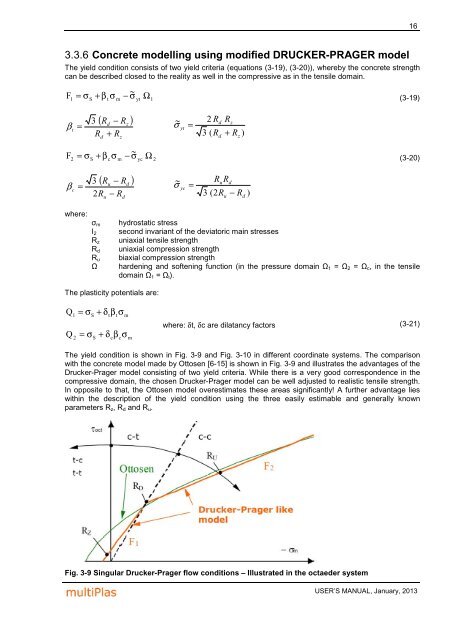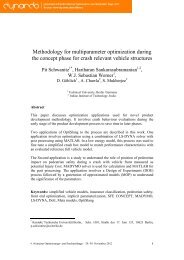multiPlas - Dynardo GmbH
multiPlas - Dynardo GmbH
multiPlas - Dynardo GmbH
You also want an ePaper? Increase the reach of your titles
YUMPU automatically turns print PDFs into web optimized ePapers that Google loves.
3.3.6 Concrete modelling using modified DRUCKER-PRAGER model<br />
The yield condition consists of two yield criteria (equations (3-19), (3-20)), whereby the concrete strength<br />
can be described closed to the reality as well in the compressive as in the tensile domain.<br />
F σ + β σ − σ~<br />
Ω<br />
1<br />
= (3-19)<br />
S<br />
t =<br />
R<br />
3<br />
β<br />
2<br />
S<br />
t<br />
m<br />
( R − R )<br />
d<br />
d<br />
+ R<br />
F σ + β σ − σ~<br />
Ω<br />
β =<br />
c<br />
where:<br />
c<br />
z<br />
m<br />
z<br />
yt<br />
yc<br />
1<br />
2<br />
~ σ<br />
yt<br />
=<br />
2 R<br />
d<br />
3 ( R<br />
d<br />
R<br />
z<br />
+ R<br />
z<br />
)<br />
= (3-20)<br />
3<br />
2R<br />
( R − R )<br />
u<br />
u<br />
− R<br />
d<br />
d<br />
~ σ<br />
yc<br />
=<br />
R<br />
3 ( 2<br />
u<br />
R<br />
R<br />
u<br />
d<br />
− R<br />
d<br />
)<br />
σm hydrostatic stress<br />
I2 second invariant of the deviatoric main stresses<br />
Rz uniaxial tensile strength<br />
Rd uniaxial compression strength<br />
Ru biaxial compression strength<br />
Ω hardening and softening function (in the pressure domain Ω1 = Ω2 = Ωc, in the tensile<br />
domain Ω1 = Ωt).<br />
The plasticity potentials are:<br />
Q = σ + δ β σ<br />
1<br />
2<br />
S<br />
S<br />
t<br />
c<br />
t<br />
c<br />
m<br />
Q = σ + δ β σ<br />
m<br />
where: δt, δc are dilatancy factors<br />
16<br />
(3-21)<br />
The yield condition is shown in Fig. 3-9 and Fig. 3-10 in different coordinate systems. The comparison<br />
with the concrete model made by Ottosen [6-15] is shown in Fig. 3-9 and illustrates the advantages of the<br />
Drucker-Prager model consisting of two yield criteria. While there is a very good correspondence in the<br />
compressive domain, the chosen Drucker-Prager model can be well adjusted to realistic tensile strength.<br />
In opposite to that, the Ottosen model overestimates these areas significantly! A further advantage lies<br />
within the description of the yield condition using the three easily estimable and generally known<br />
parameters Rz, Rd and Ru.<br />
Fig. 3-9 Singular Drucker-Prager flow conditions – Illustrated in the octaeder system<br />
USER’S MANUAL, January, 2013






